Museums and Exhibitions in New York City and Vicinity
| Home | | Museum Guide | | International | | Architecture & Design | | Theater |
GLENN LONEY'S MUSEUM NOTES
CONTENTS, March 26, 2000
[01] Biennial 2000 at the Whitney
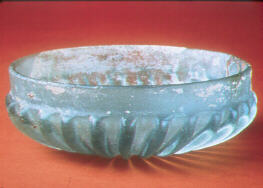
ROMAN RIBBED BOWL--Rare 1st century AD glass vessel on view in "Roman Glass" at Bard Grad Center for Decorative Arts.
[02] Nam June Paik's Video Magic at Guggenheim
[03] "Making Choices" at MoMA
[04] "Painters in Paris" at the Met
[05] "Cabinet of Wonders" at BMA
[06] BMA's "Realm of Marvels"
[07] "Roman Glass" at Bard Center
[08] Richard Prince in Vienna
[09] "Works on Paper" at Armory
[10] Tokyo's Mori Art Center
You can use your browser's "find" function to skip to articles on any of these topics instead of scrolling down. Click the "FIND" button or drop down the "EDIT" menu and choose "FIND."
For editorial and commercial uses of the Glenn Loney INFOTOGRAPHY/ArtsArchive of international photo-images, contact THE EVERETT COLLECTION, 104 West 27th Street, NYC 10010. Phone: 212-255-8610/FAX: 212-255-8612.
Copyright © 2000 Glenn Loney.
For a selection of Glenn Loney's previous columns, click here.
This year, the volume and heat-levels of the pro-and-con discourse about the new show will surely be turned down. Possibly way down.
This is not because "Sensation"—unveiled at the Brooklyn Museum of Art last fall—used up all the moral and aesthetic outrage some New Yorkers keep on hand at all times, in order to protect schoolchildren and weak-minded adults.
There is an art-installation in the new show which makes a direct reference to Mayor Rudy Giuliani's attack on the Brooklyn Museum. It seems calculated to provoke the Mayor's righteous wrath yet again.
As an innovative Installation, however, it fails the test. Into a small black-box of a room are crammed open garbage-containers in rows, complete with black liners. On the facing wall above them are three American Flags, flanked by three anti-art declarations made by the Mayor. And, balanced on the other side of the Jasper Johns-style flags, are three quotes from those noted National Moralists and art-critics Pat Buchanan, Jesse Helms, and Pat Robertson.
The partial text of the First Amendment was on the floor between the trash cans. OK—this makes a point. But not with much originality or imagination at work. Yet the room was stuffed with TV cameramen and arts journalists at the press showing.
There is almost nothing in this show that seems deliberately calculated to offend the easily upset, or even to provoke stimulating arguments about the nature, purpose, and possible future of the arts in America.
Unfortunately, much of the work looks like spin-offs of earlier avant-garde experiments by now well-established innovators. Who are much missed in this exhibition.
There is hardly anything as outrageous as some of the installations at the last two Whitney Biennials, organized under the aegis of former Museum Director David Ross, who is now rattling the cages at San Francisco's Museum of Modern Art.
When the Whitney's new director, Maxwell Anderson, arrived on Madison Avenue, some conservative art-lovers breathed a sigh of relief. He hadn't mounted any outrageous shows in Toronto, so he might prove safe and sound for the Whitney.
The new show certainly seems not only tame but almost déjà vu. There are even some figurative paintings which—although stylized to make possibly satiric comments on such conventional images—are almost pretty.
A pink convertible—with lace-doilies as hubcap covers—might have been a lively culture-shock back in the 1960's, but it really looks old-hat, or old-car, now.
Dulling the Cutting-Edge:
[Closing June 4]
Every two years, the Whitney Museum of American Art can be counted on to create an Art Scandal which will have both art-lovers and culture-haters shouting and fuming for months. The occasion is always the Whitney's much-disputed Biennial Exhibition.
Biennial 2000 at the Whitney
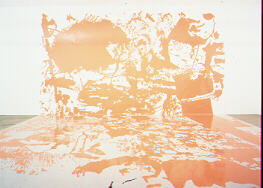
| |
| CALAME—NOT CALAMITY--Ingrid Calame's contribution to the Whitney Biennial uses enamel paint on trace mylar! | |
Tara Donovan has apparently spent many, many hours stripping very thin electrical wiring of its cladding. She has arranged what must be many thousands of tiny wire fragments into a squared installation, bounded on three sides by gallery walls.
Named "Ripple," the work looks like the concentric rings which would result from dropping a stone into a misty grey pool with a surface of dust.
Walter De Maria used to shock by filling entire rooms with truckloads of raw dirt or plucked peat. He surely must have been a seminal influence on Donovan? But his creations were a lot less labor-intensive.
BA—or Before Anderson—there were regular complaints that the Biennial was a Closed-Shop, too New York-Oriented, too Agenda-Driven, and even too Artist-Curator Incestuous. Incest was suggested by the transformation of curators into artists themselves—by virtue of their virtuoso selections and creative wall-texts.
For this Biennial, Anderson chose six non-Whitney curators from around the nation. They, in turn, would ensure that the show broadly reflected new art and artists in America. This may well be the case. If so, new American Art needs a booster-shot in the paint-tube or the posterior.
Two of the curators are from California institutions. One's from Fort Worth. Another is from Chicago. The final two are based in Boston and Hartford. The rest of the United States must still be the Cultural Wasteland we so often hear deplored.
For those who cannot afford—both for reasons of apartment-space and budget—to own original artworks, it is still a pleasure to go to art museums and galleries to admire and study paintings, graphics, sculptures, and installations.
But the Wave of the Future promises something rather different: We may all be watching experimental films in tiny black-boxes or squinting at projected computer-art. Surveying Internet artworks on small computer-monitors seems even more reductionist. You don't need to go to a museum for that.
The idea of paying good money to go to a museum to stand or crouch in a black-box—to watch an out-of-focus watery blue image shimmer and shake on a dim screen—may seem crazy to some old-timers. As one mature colleague said: "You wouldn't stand—or sit—for this stuff even at the Angelika!"
Judging from the blurry quality of some of the still and moving photographic images at the Whitney, throwing away your slides or prints just because they look over- or under-developed is an act of artistic folly. Your inability to master the technology of your camera and lens could make you a cutting-edge avant-gardist.
Much is made of the 97 artists represented in the Biennial at the Whitney Museum of American Art. But 21 of these were not born in the United States. They are now residents, of course. Otherwise, they'd not be included.
This inclusion is alleged to demonstrate—in the words of Director Anderson: "… the strong pull the nation has for artists from all over the world." In itself, this is no great recommendation. Scores of illegal busboys and cleaning-ladies have also responded to the "pull of the nation."
This immigrant-inclusion could be seen as a threat to the survival and development of a distinctively American art. Why, after all, was it initially thought necessary to found a museum devoted exclusively to American artists and their visions?
Fortunately, as so many would-be artists abroad are trying to imitate America's cutting-edge artistic creations, American Art must now be so well established that it no longer needs either special pleading or a special museum.
Even though there are more artists included this time, the floor-space is less crowded with major and minor works than before. Not that everything is on small scale, but there are fewer gallery-gobbling installations than before.
And a lot of space is walled off to create large and small black rooms in which shimmering, stuttering images are projected. These cannot accommodate crowds. Even with only a few viewers, people "just passing through" can obstruct the images.
If this fascination with videos and computer-generated graphics seizes the popular imagination, it will soon be unnecessary to have a real Biennial. Think of the money that could be saved! Think of the hundreds of new artists who could be included—from every nook and cranny of the country!
A VIRTUAL BIENNIAL—viewed leisurely, without crowds, in the privacy of your own home—will put the entire exhibition at your fingertips!
Of course, those unfortunates who obstinately continue to live in the Third World will still be SOL. If you haven't enough pence for food, you certainly won't be on-line.
At the Uptown Guggenheim:
The [Virtual] Worlds of NAM JUNE PAIK
[Closing April 26]
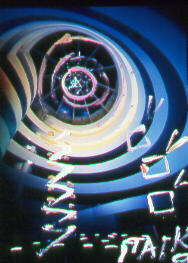
| |
| SURREAL SPIRAL ROTUNDA--Nam June Paik makes electronic magic at the Guggenheim. | |
On one of the spiraling slopes of the Guggenheim Museum, he has arranged a row of compact aquariums with same-size TV monitors set immediately behind them. The video images he's provided for viewing look even better seen through water and a constantly moving array of glittering little fish!
The space required for your Leisure-Time Home Entertainment Center is instantly minimized. And viewer-enjoyment is infinitely enhanced.
The fish could get cancer from toxic TV emanations, but they are not big enough to eat anyway, so why worry about their health problems?
The New Age magic Nam June Paik has conjured from television, videos, and related electronic technologies instantly engulfs visitors to the Guggenheim as they enter the great spiral rotunda.
The floor is almost filled with a circular array of TV monitors, their screens pointed toward a circular fabric at the top of the spiral ramp. A fascinating variety of video imagery dances across the tube-surfaces, much of it replicated on other monitors.
From the midst of the dense cluster of TVs, brilliant and rapidly transmuting laser-designs are projected toward the dome.
A steady sheet of raindrops fall from that height all the way down to a pool behind the floor monitors. It is bracketed by a series of mirrors on cables. These deflect a bright green laser beam at the top into a green zigzag ladder, made luminous by the falling drops of water. This light-sculpture is called "Jacob's Ladder."
The rotunda show alone is worth the price of admission. Looking upward, visitors can see large projection screens mounted on the edges of the spiral's outer walls. These feature video images also seen on the floor and in other video-contexts.
Enlargements and distortions of a simple candle-flame are made possible by Paik's manipulation of TV technology. On one section of the spiral a downward descending—or upward ascending—row of TV monitors shows the phases of the moon.
Some of his installations are almost cultural spoofs, but they carry admonitory suggestions as well. What will eventually happen to a Third World nomad, watching TV images in his hut? Will he herd his yaks with a mobile TV camera?
Paik has some visual fun in making robot-like figures from stacked and linked TV sets. Some of the sets are vintage in the extreme. In one robotic TV figure, he has even incorporated old radio-cases.
But he makes them into TV sets as well, by putting small monitors into their dial and loudspeaker openings. Paik-devised video-imagery seen elsewhere in the show can also be glimpsed on these humanoid collages of TVs.
In the great 1960s heyday of Happenings, Nam June Paik was in the forefront of experiment, both on tape and in live performance. His experiments with Charlotte Moorman—who won notoriety by playing the 'cello both bare-breasted and completely nude—are recalled in photos and videos. He created a bra for Moorman, made of two small TV monitors. Literally: BOOB TUBES!
He has even provided some interactive TV monitors in this show. Shout, sing, cough, or bark into a microphone and see astonishing variations in the moving bands of color on the screens!
An elegant ritualistic Korean dance is presented on a variety of monitors of various sizes, set into lush tropical leafage. The dance-video has itself been visually enhanced by Paik's overlays of the changing outlines of the dancer and the ritual objects involved.
One darkened chamber is devoted to three laser-sculptures. One functions in a three-sided solid with mirror-walls. As the laser-beams sweep rhythmically back & forth, they are multiplied and interwoven.
So Paik's varied installations at the Guggenheim show his imagination and innovation at work in a wide range of creation: from visual jokes to high art.
Way back in the Peace & Love Sixties, Brice Marden was at work in San Francisco on a grant, in association with Station KQED, to explore the possibilities of TV art. This had nothing to do with artistic programs. Perhaps we'd already given up hope in that area of the TV Wasteland.
Marden's focus was to see what might be done to create interesting visual effects by tinkering with TV circuitry and related technologies. And to employ unusual camera and transmission technologies in recording consciously avant-garde performance art. He taped Tom O'Horgan's LaMaMa Troupe in a riotous evocation of an Old Norse Epic, the Heimskringla.
Marden may have been a pioneer, but Nam June Paik has proved himself a tireless explorer of video worlds beyond our imagining.
One discovery Paik made quite early has now been adopted by theme-parks, museums, and even shoe-shop show-windows. This is the visual impact of even a quite ordinary moving video image, replicated on a massed wall of TV monitors.
The rows and files of synchronously moving images suggests the dynamic effect of the precision-dancing of the Rockettes. It is even hypnotic, if one watches long enough.
Old Wine in New Bottles—
Old Artworks in New Contexts—
"Making Choices" at MoMA
[Closing August 22]
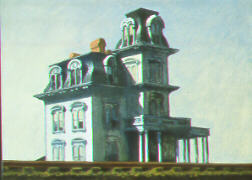
| |
| MoMA MAKES MILLENIUM CHOICES--Edward Hopper's House by the Railroad makes the curatorial cut in "Making Choices." | |
Why not begin collecting all over again, beginning with 1 January 2000? Or 2001, if they have calendar-problems with the Millennium?
Think of the wall and floor-space that would be freed up for the steadily growing gigantism in museum-scale artworks!
In the meantime, curators at MoMA have discovered an engaging device for recycling seldom-seen works and over-exposed old favorites. This was initially tested last year with Making Starts, shown on three floors in three sections: PEOPLE, PLACES, and THINGS.
Instead of focusing on schools or movements, these three exhibitions were organized around subject-matter, loosely interpreted. These themed presentations proved tremendously popular, even with the critics.
Canvases and sculptures which had become all too familiar, when set alongside relatively unknown works in the new contexts, invited closer inspection, renewed acquaintance, and increased appreciation.
This engendered greater appreciation for the familiar works not only as art. And not only for the special styles and technical skills of the artists. But it inspired admiration also for the paintings, graphics, and sculptures as expressions of artists' visions of the world and the people and things which inhabit it.
Art for Art's Sake has had its aesthetic day. It has been followed for some time now by Art for the Artist's Sake.
But it's not just the unsophisticated public which has long really wanted to know: What does it mean? If it doesn't mean anything that words can explain, what's it about? Why did he or she create it?
The new series of three Making Choices shows at MoMA may suggest some interesting answers to such questions.
As in the previous trio of exhibitions, drawn from the permanent collections, most of the works chosen by MoMA curators are organized by topics, themes, or genres. This must be what is meant by the new thrust of "Narratives" in preparing artworks for exhibition: Themes instead of Schools or Styles.
The first section includes such thematic sub-shows as "War," Modern Living 1," "The Dream of Utopia/Utopia of the Dream," "Graphic-Photographic," and "Modern Art despite Modernism."
This last category features some hundred works—from 1920-1980—by artists whom curators consider to have challenged or rebelled against the canons of Modernism. It may come as a surprise to some to discover Picasso, Matisse, Max Beckmann, Frida Kahlo, and Francis Bacon among these rebels. It's less astonishing, of course, to find works by Paul Cadmus, Andrew Wyeth, Balthus, Ivan Albright, and Fairfield Porter included. There is a special catalogue to explain it all.
Picasso is all over the place—not only because MoMA owns so many of his works—but also because his wide range of experimentation entitles him to inclusion in a number of categories.
Although "Making Choices" focuses largely on the period 1920 through 1960, its "Paris Salon" provides a welcome link to the Met's new examination of the School of Paris and its heirs: "Painters in Paris: 1895-1950."
"War" is the most powerful of the themed exhibitions. And not just because of its grisly and wide-ranging potential subject-matter. War's scenes and machines, its cruelty and destruction: all call forth strong and varied visual and technical responses from artists as diverse as Arbus, Dix, Severini, Kubin, Warhol, Picasso, Gontcharova, Spiegelman, and Kollwitz.
Curiously enough, Hans/Jean Arp gets a room all to himself, as does Giorgio Morandi and selected etchings. Architect Louis Kahn and photographer Man Ray also rate individual showings on the ground-floor.
Someone made a choice of a seminal 20th century architect, and the winner wasn't Frank Lloyd Wright obviously.
Man Ray's techniques and images are certainly impressive, but is he the epitome of modern photographic innovation? "Making Choices" may have an interesting side-effect of provoking dialogue—strong argument, even—regarding choices made.
For balance, the photos of Walker Evans—currently featured in a major show at the Met—have their own space, shared with images created by temporal or spiritual colleagues such as Atget, Weston, Sander, Arbus, Eggelston, Sherman, Friedlander, Hopper, Frank, and Morris. There's even a special catalogue celebrating Walker Evans' varied achievements in creating a record of a painful segment of the American Century. He was, after all, something of a MoMA discovery.
The second section, just opened, features "The Marriage of Reason and Squalor," "The Raw and the Cooked," and " Useless Science."
Closing September 26, the third section of "Making Choices" completes the roster of 24 shows within the larger exhibition. Its elements include "Paris Salon," "Home Movies," "The Rhetoric of Persuasion," "Modern Living 2," "Anatomically Incorrect," "How Simple Can You Get?," "Seeing Double," "New York Salon," "The Observer: Cartier-Bresson after the War," "Ideal Motif: Stieglitz, Weston, Adams, and Callahan," and the Shigeru Ban Paper Arch over the museum's garden. The arch, however, is scheduled for dismantling in early August.
On the evidence of the initial section's choices and presentation, this trio of MoMA exhibitions should prove very attractive both to New Yorkers and tourists. One thing is certain: many regular visitors to MoMA will be both surprised and delighted to see some of the less known works which have so long languished in temperature-controlled storage.
Going to the School of Paris at the Met:
"Painters in Paris: 1895-1950"
[Closing December 31]

| |
| LÉGER'S LEGERDEMAIN--Woman with a Cat in the Met's "Painters in Paris." | |
One of the distinct advantages of both MoMA and the Met mounting major exhibitions from their vast—and often unseen—holdings is making it possible for the public to view a range of largely unfamiliar works by major brand-name artists and also paintings and sculptures by talents relatively unknown to them.
At MoMA, there seem to be sufficient Picassos to include in almost every "narrative," or category, its curators can devise. At the Met—with the current survey of Modernist developments in the School of Paris—Picasso's explorations and experiments also accord him representation in successive periods.
The powerful, formative influences of the School of Paris on generations of painters—and not only French artists—certainly left their marks on much of the art of the early 20th century.
In the 19th century, Paris had already achieved the apparent pinnacle of artistic style and perfection. Talented young men—and some indomitable women—who wanted to become architects, sculptors, or painters had to go to Paris to study. Even to make their careers there.
One could study in London or Munich, but Paris was the preference. Vienna was hardly a magnet for novice artists.
One certainly could go to Rome, but often only after training in Paris. Rome was more about Classical and Renaissance inspiration than about training.
Most of the major art movements of the late 19th and early 20th century began and prospered in Paris. Or they were inspired or affirmed by experiments in Paris.
The great art exhibition at the 1900 Paris Exposition Universelle—soon to be seen in reconstituted form at the Guggenheim—showcased these emerging movements. And it showed provocative canvases by non-French painters, also exploring these new ways of seeing.
The new/old exhibition at the Met focuses on 36 painters—with over a hundred of their works on view—representing important movements in the School of Paris. The Fauvists, the Cubists, and the Surrealists are highlighted.
This show is a Cezanne-free environment. But Bonnard, Braque, Derain, Dubuffet, Dufy, Léger, Matisse, Monet, Picabia, Rouault, Rousseau, Utrillo, and Vuillard are well represented.
Before Diego Rivera evolved his distinctive Mexican muralist style, he tried his hand—along with Picasso and Braque—at Cubism. So he is on view, as are such other non-French but definitive Modernists as De Chirico, Miró, Severini, Modigliani, Gontcharova, Gris, and Giacometti.
Of course the eminently French Balthus is not overlooked. He certainly could have endorsed the sentiments of one of Maurice Chevalier's favorite songs: "Thank Heaven for Little Girls!"
De Chirico's haunting symbolic landscapes—with mysterious towers and empty colonnades—are emerging from the storage vaults not only in this Metropolitan show, but also at MoMA.
Anyone interested in the development of art in this century should not miss the exhibitions at both museums. When they are dismounted, it's back to the vaults for some very impressive pictures. And you won't see them again soon.
At the Brooklyn Museum of Art
Both Wonders & Marvels on View:
The Guennol "Cabinet of Wonders"
[Closing May 7]

| |
| ENIGMATIC AFRICAN FACE--Famous fragment of a head from Nigerian Ife in the Guennol Collection at BMA. | |
Some of them—such as the noted classical head from Ife—have become art-icons, outstanding exemplars of art and especially of the artistic vision of particular cultures.
These are treasures from the wide-ranging collections of Alastair and Ethel Martin, many on loan or given outright to the museum. The peculiar name Guennol is Welsh for Martin—where the Martins spent their honeymoon.
The exhibition sub-title—"Cabinet of Wonders"—alludes to the European tradition of the Wunderkammer. Even in the Middle Ages, men of wealth, power, learning, and curiosity collected rare and precious objects, paintings, sculptures, jewels, manuscripts, talismans, and even Unicorn Horns.
In the Renaissance, this mania for assembling collections of curiosities became a positive passion, even with Cardinals and Kings. One of the most interesting of such collections to survive is the Wunderkammer of the Cardinal-Archbishops of Salzburg.
In addition to mummified manatees, it has not one, but several unicorn horns! Of shiny yellowing ivory, with spiraling ribbings, these are of course the horns of Narwhals.
They are not carved fakeries, but they certainly were not sawed from innocent unicorns. Come to think of it, you don't see many Narwhals now either.
The Martins have been even more eclectic in their collecting than such Salzburg Prince-Archbishops as Markus Sittikus, Wolf Dietrich, and Paris Lodron. But then the world has been wide open to them, as it was not for most collectors even two centuries ago.
Instead of devoting themselves to perfecting a collection of, say, Early American Furniture—or Pre-Columbian Pottery—the Martins have acquired whatever seems to have struck their fancy. Here is a goddess from ancient Persia; there, a 19th century German Noah's Ark, complete with pairs of naively carved wooden animals.
Customarily, such works are shown in museums—including the BMA—in rooms or cases devoted to historical periods, distinctive movements and styles, or national and ethnic groupings.
Now the Martin's beloved objects are being exhibited in a quite different context: "…emphasizing the creativity and independence of the Martins as collectors…."
This sounds a bit strange: to compliment obviously intelligent, discriminating, and wealthy people for having the courage to buy what they like and enjoy. Rather than devoting their lives to amassing the world's largest collection of Vaseline Glass.
But the Martins certainly do have great taste. And they've made some stunning acquisitions. It's a wonderful wonder that they have been so generous to share this Wunderkammer with the BMA and its metropolitan viewers.
A number of the Guennol treasures are fairly small—antiques and collectibles you could easily bring back from distant lands in your purse—but they have been so artfully displayed that their beauties are highlighted, rather than eclipsed.
The handsome paperback catalogue reproduces the smallest of the objects larger than life and in wonderful, colorful detail. Some of them look better in the photographs than they do in the cases.
This special exhibition not only salutes the taste, acumen, and generosity of the Martins to the BMA—he is a trustee, after all—but it also could encourage other discriminating collectors to share their finds with the Brooklyn Museum as well.
In line with the emerging museum-exhibition philosophy of developing new "Narratives" for displays of artworks, the Guennol installation certainly makes a distinctly human connection.
Not so much with the various known and unknown artists and their cultures—that is done in the galleries where the Guennol masterpieces are ordinarily on view—but with the highly eclectic arts & crafts interests of two people whom you will surely feel would be wonderful to meet. And to talk with them about their adventures in collecting.
Building BMA Collections: "Realm of Marvels"
[Closing June 18]
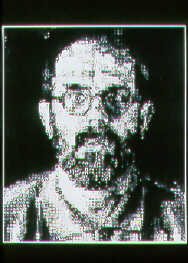
| |
| CLOSE CLOSE-UP--1995 Self-Portrait of Chuck Close in BMA's "Realm of Marvels." | |
The Museum's good fortune, even in its earliest years, was to begin building definitive holdings relating to the native cultures of the American Southwest and in Central and South America.
As with the Hearst/Kroeber Museum at UC/Berkeley, the BMA began collecting the arts and crafts of the American Indian when many handsome and/or historic objects were still being sold as souvenirs in the Far West.
In the historical Americas, the arts of Colonial Spain in Mexico and Peru were also acquired, as were outstanding examples of the Pre-Columbian arts of the Aztec, Olmec, Maya, and Inka.
The BMA, as all major museums, has thousands of artworks and artifacts that are seldom or never on view. Bona fide scholars, researchers, and students, of course, can gain access to works which are important for them to examine.
But public has no idea of the extent and breadth of the holdings at the BMA. Those who may have asked: "Do you have anything else this great in the basement?" can now have their curiosity at least partially satisfied.
This show could be called The Narrative of What and How We Collect—and Why It's Not All on View All the Time. With over 1.5 million objects from almost every culture in the world—living and dead—BMA curators have to be very highly selective in what they show.
Notable, even beloved, treasures of the Brooklyn Museum are highlighted in the fifteen collection-areas of this exhibition. But they are shown in the context of other works or objects not so well known—or so long in storage that few museum visitors could possibly remember ever having seen them on display.
Some of these artworks or objects are clearly not as remarkable, or well-made, as the often-seen masterpieces. The comparisons made possible by creating such contexts Show rather than Tell.
Two shelf-levels of chairs, for instance, are centered on George Hunzinger's 1869 New York patented upholstered chair. Actually, it's upstaged by an elaborately stuccoed and gilded armchair from Peru. This gaudy piece of furniture is the kind of quasi-throne the Colonial Viceroy might have felt exactly suited his exalted station.
The wall of elegant gowns—from the BMA's admired and extensive costume-collection—is keynoted with a stunning Charles James evening-gown, once a favorite of the sophisticated stripper, Gypsy Rose Lee. But it doesn't eclipse the elegance of an Elsa Schiaparelli evening-coat or a rich renaissance-velvet cloak by Mariano Fortuny.
Also on view—on the rack, so to speak—are lovely gowns donated to the Museum Collection by film-star Janet Gaynor and socialite-philanthropist Mrs. William Randolph Hearst Jr. They are by Adrian and Dior, respectively.
There may be another lurking Narrative implicit in this show.
The shockwaves of disapproval from City Hall and the "NY Post"—as well as the heavyweight legal attacks on the BMA by the Mayor himself—may temporarily have depleted some of the in-house funding for mounting new shows.
Or the scandal created thanks to the museum's sensational fall show, "Sensation," may have forced a change of plans. If that were the case, what could be better than digging out some of the wonderful stuff the public hasn't seen before—or for a very long time?
At the Bard Grad Center—
"Roman Glass: Reflections on Cultural Change"
[Closing June 11]

| |
| ROMAN RIBBED BOWL--Rare 1st century AD glass vessel on view at Bard Grad Center for Decorative Arts. | |
The large and handsomely designed illustrated wall-panels are also important in demonstrating how and why fashions in—and uses of—glass changed from late antiquity into the Seventh Century AD.
Considering the great fragility of early glass, it is also remarkable that such finely wrought and artfully decorated phials, vases, and bowls have survived. This happened because precious and beloved objects were customarily interred with the urns of ashes in pagan burials.
Other finds have been recovered from the long-buried ruins of ancient cities. These have often had to be reconstructed from surviving fragments.
The compactly packaged exhibition has been curated by Dr. Stuart Fleming of the University of Pennsylvania Museum. He's also Scientific Director of its Applied Science Center for Archaeology.
Scientific attention is certainly paid to the materials & techniques employed in developing glasswares from the late Second Century BC onward to the end of the dominance of Rome in the Mediterranean and Europe.
Archeological sites where objects on display have been recovered are also noted. Maps and diagrams are also useful in this regard.
But the developmental thrust of the exhibition is not about finding lost treasures, preserving ancient glass, or even about how Greeks and Romans made glass—though that is clearly important.
In demonstrating how glass-making responded to changes in political life, economic well-being, and trends in taste, culture, and even religion, this show becomes Humanist Historical as well as scientific.
When such glass treasures are on show in museums & galleries, they are often presented as artworks, rather than as either scientific finds, or socio-economic indicators. So this outstanding exhibition is also different in that regard.
It's also a compact survey of Roman Rule over the centuries, as well as an introduction to the daily routine of Roman citizens. Their day was divided into twelve hours, and they enjoyed their major meal—with fine glasswares—at the Ninth Hour.
Romans and Greeks still like to take their dinners in the cool of the later evening. But the glassware in modern restaurants and tavernas is nothing like the lovely objects in this show at the Bard Graduate Center.
This is a show of recent work at the MAK Galerie, Vienna's intensely avant-garde museum of decorative and applied arts. The catalogue is titled: "The Girl Next Door."
A photograph inside the official opening invitation, however, shows a busty bare-breasted blonde. She looks nothing like the conventional image of a girl-next-door.
MAK makes the point that much of Prince's work has been a kind of visual confrontation and argument with clichéd conventions of advertising imagery. Peter Noever, Director of MAK, salutes Prince's art for being subversive, exhilarating, and dead-earnest.
Concurrently, there is also a Richard Prince show on view in MAK's Los Angeles Center for Art & Architecture. This is called "UPSTATE". Photos on the invitation cover look rather like the fields of that spacious Storm King Mountain Art-Park. Richard Prince on View in Vienna
[Closing April 28]
If you are disappointed, even devastated, to discover that cutting-edge artwork by Richard Prince is not included in the new Whitney Biennial 2000, you could fly off to Vienna to see "4x4."

| |
| ART TO SCRAPE TOKYO'S SKIES--Design for Mori Art Center's main gallery atop new high-rise office-complex. | |
To be called the Mori Art Center, it will crown the Mori Building Company's main office-tower in the innovative Roppongi Hills complex of offices, residences, parks, and cultural venues.
This structure will top out at 54 floors. The topmost floors will contain four state-of-the-art modern galleries. On the floor below, there will be both interior and panoramic galleries, with outdoor terraces offering breathtaking views of the city of Tokyo.
Introducing his vision recently in New York at the Museum of Modern Art, Mori explained his belief in the importance of culture as a strong component of any site or area where people live and work.
The MBC tower is only one of a number of handsome buildings being built by the firm for business, housing, and recreation. In Central Tokyo, the entire project—but especially the Mori Art Center—will be both a landmark and a symbol of this great modern city.
The Mori will not create its own permanent collections in modern art, architecture, and design. At this late date, such acquisitions could prove impossibly expensive.
Rather, the Mori Art Center will be an international venue for exhibitions from major museums all over the world. London's Royal Academy of Arts and MoMA are involved in planning and collaborating on new shows.
MoMA's director, Glenn D. Lowry, emphasized that its current role is largely that of a consultant on planning the galleries and associated matters. Its advisory relationship with the Mori Art Center will not preclude previous exchange agreements with other Tokyo museums, Lowry stressed.
Yes, there's a new website with more information about the Mori: www.moriart.org
[Loney]
Copyright © Glenn Loney 2000. No re-publication or broadcast use without proper credit of authorship. Suggested credit line: "Glenn Loney, Curator's Choice." Reproduction rights please contact: jslaff@nymuseums.com.